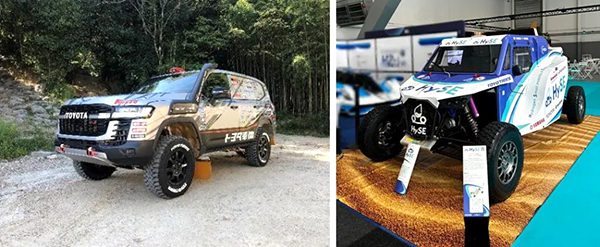Lighter, more controlled and an adrenaline rush
What is it?
Let’s start with the bad news: The Lotus Exige Sport 350 is not U.S. road legal. The good news? Lotus already sells around 50 Elise and Exige models annually here, where they’re used on-track and raced in the Lotus Cup U.S.A. So if you really want an Exige Sport 350 and you’re happy to just drive round in circles at high speed, you can.
There’s some even better news, too: New Lotus boss Jean-Marc Gales recently told Autoweek he wanted the U.S. to become Lotus’s biggest global market. So the next Elise and Exige — successor to the Sport 350 we’re testing — will be federalized for the U.S. when the new models land in 2019 or ’20. So this drive gives a taste of what’s heading our way.
Lotus has a storied history in the U.S., not least Jim Clark’s 1965 Indy 500 win, the first for a mid-engine race car. Fifty years on, the Exige Sport 350 holds true to founder Colin Chapman’s vision of “adding lightness.”
The Exige first bowed in 2000 as a hardcore coupe version of the Elise roadster. In 2012, Lotus put more fresh air between the two, replacing the Exige’s four-cylinder motor with the same Toyota-sourced and supercharged 3.5-liter V6 found in the Evora. It created the Exige S, the only new Lotus launched under previous boss Dany Bahar, who promised a radical product blitz. In the U.S., we get it as the track-only V6 Cup, an even more track-focused, lighter version costing $ 99,950. The Sport 350 basically evolves the Exige S, but laps faster and is 11 pounds lighter than the V6 Cup. For now, Lotus intends to keep selling the V6 Cup here, but is bringing the Sport 350 in as a special order.
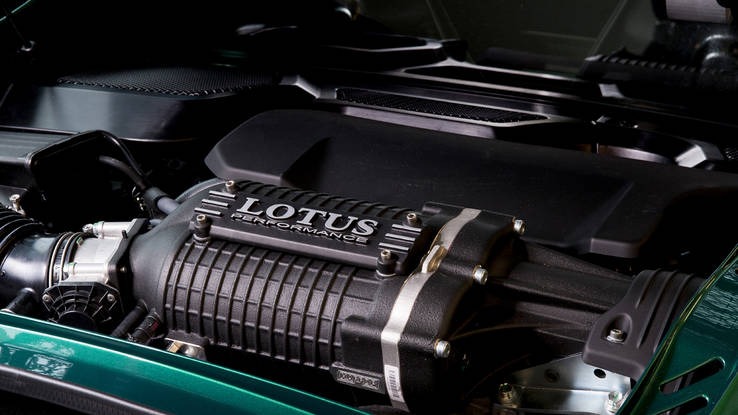
The supercharged 3.5-liter V6 makes 345 hp and delivers sprints from 0-60 in 3.7-seconds.
The Exige uses the Elise’s extruded and bonded aluminum tub, and its center section is identical, but new front bodywork creates a more aggressive identity, while there’s a revised rear subframe and bodywork to house the transverse mid-mounted V6.
Last summer, Lotus took apart an Exige S, had students weigh the parts, and got engineers, line-assembly staff and suppliers to suggest ways to add lightness, ideally also improving the effectiveness and quality of component design. The exercise yielded 120 ideas, creating the Sport 350.
Changes include a louvered composite engine cover to replace the previous glass item (-6.6 pounds), a new battery and mounting bracket (-7.7 pounds), lighter body panels (-26.5 pounds), removing some sound deadening (-6 pounds), replacing the handbrake (-0.57 pound!), and deleting the sun visors and the passenger foot rest (2.6 pounds). The Exige has been homologated without air-conditioning, shaving 16.5 pounds and will doubtless be added back as an option in most cases.
All in, the changes cut 112 pounds. Power remains 345 hp and 295 lb-ft, but a 2,480-pound curb generates a healthy 7.12 lbs-per-hp power-to-weight ratio. The Porsche 911 GT3 (475 hp/3,318 pounds) punches only slightly harder with 6.99 lb-per-hp.
It’s enough for the Sport 350 to lap Lotus’s Hethel test track in 1:29.8 sec, 2.5 seconds faster than the Exige S — particularly impressive because the S’ time was set on optional Pirelli Trofeo tires, no longer road legal, where the Sport lapped on less sticky P-Zero Corsas. The tires are 205/45 R17s front, 265/35 R18s rear, the latter stretched over half-inch wider rims for a wider footprint.
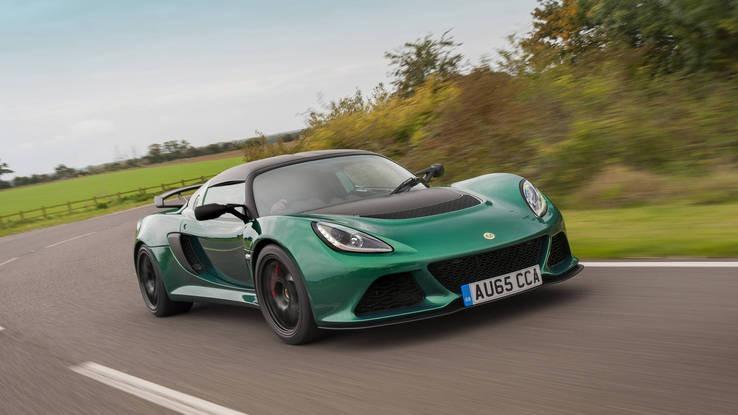
What’s it like to drive?
The Exige S is raw, focused and fun, with many compromises you’d expect. With a low roof and thick sills fanning out towards the foot well, entering the Exige’s cabin is tricky. Once inside, your feet are skewed dramatically towards the transmission tunnel, like Queen Elizabeth riding side-saddle.
Still, it’s a pleasingly minimalist and comfortable driving environment. The seats are low-slung and thinly padded, yet supportive and surprisingly comfortable; the tiny steering wheel doesn’t adjust, but it doesn’t seem to matter, and the manual gear change is less than a hand’s span away from your right hand. Its exposed gear linkage is like glimpsing The Terminator’s metallic endoskeleton beneath living flesh. Nice touch.
You can option leather or Alcantara trim, but our car came with Tartan looking like Jackie Stewart’s pants — Lotus calls it a reference to the 1976 Esprit S1.
On the road, the Exige feels hardcore, if still retaining a high degree of usability. The engine can’t muster a Cayman’s goose-pimple-producing soundtrack, but the torque flings you down the road from barely idle speed, and keeps on delivering past 7,000 rpm. Don’t let the lowball power figures mislead you, this is serious speed.
The gear change helps you access the speed faster than before, too. A vast improvement on the Exige S, the shifter is short and slick, with a tactile engagement as you slot each gear home. Choose the auto if you like, but it adds weight, replaces the gorgeous exposed mechanism with an unattractive PRND panel, and is lightyears off the best dual-clutch transmissions from Porsche, BMW and Ferrari. Plus, the aluminum shift paddles have such long travel, you almost move them as far as a manual gear lever anyway.
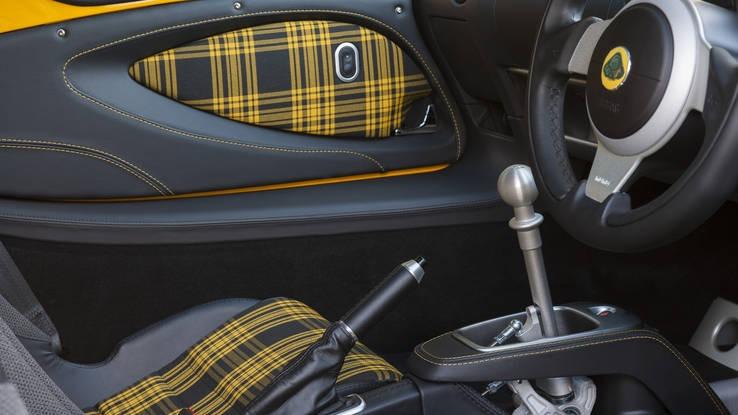
The plaid interior is more British than scones and tea, but we love it. Note, Lotus exposed the shifting mechanism to save some extra weight, and to show off how cool it looks.
The Exige’s unassisted steering is heavy at low speeds, where you have to crank the small wheel like a stubborn submarine hatch, but the benefits percolate up the rack as speeds rise: the steering constantly communicates surface information close to Porsche’s GT cars, immediately providing a deep connection.
The chassis strengthens the feeling and has also been revised: front camber doubles from 0.40 degree to 0.80 degree, front toe from 0.06 degree to 0.12 degree, and rear camber from -1.9 degree to -2.1 degree; rear camber is maxed out, an engineer says.
Firmer because the carryover springs and dampers are cushioning a lighter car, the suspension provides exceptional body control, with a ride — while far firmer than the Evora — remains comfortable enough.
Despite its firm chassis and talkative steering, the Exige never locks onto surface cambers or tugs aggressively under braking — both problems we’ve encountered with the Alfa 4C — and still soaks up surface irregularities. It gives you confidence to push, and contributes to excellent traction.
Driving a V6 Cup on the road is like tuning to radio static and cranking the stereo, and we wondered if the Sport 350 might be worse; after all it’s lighter, and Lotus has removed sound deadening. Surprisingly, you could pass a longer journey chatting to a passenger in the new model.
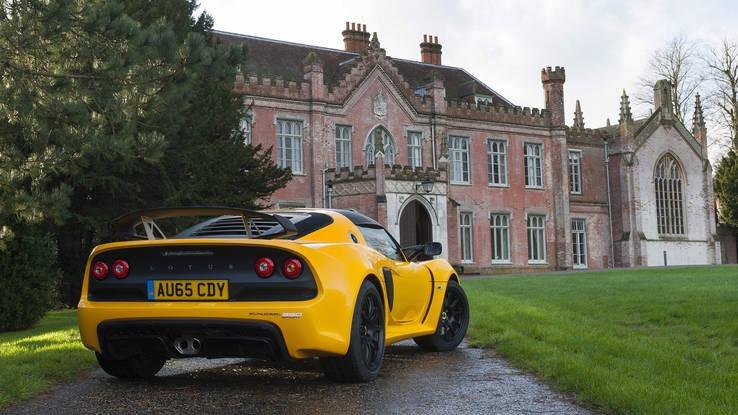
A yellow Lotus is almost a necessity at this point in time.
On Lotus’s Hethel test track, the Sport 350 comes into its own. It’s nimble, communicative and, above all, fun. You might expect long straights to diminish the 345 hp’s impact, but you surge down them in one long adrenaline rush.
The chassis changes are implemented to cut understeer, but we drove in damp conditions, understandably necessitating some patience to get the front end keyed in through tighter corners. In faster flicks, a little understeer is quickly followed by line-tightening oversteer; it’s adjustable and involving, but your inputs must be quick.
Luckily, Lotus Dynamic Performance Management is sensational, with a choice of drive, sport or more lenient race mode, the latter beautifully balances grip and slip, subtly working away in the background to judge the conditions and your driving. Combined with the optional four-piston, two-piece brakes — and their ABS safety net — you quickly feel comfortable pushing for fast laps, even in tricky conditions.
The only criticism is, it’s easy to screw up downshifting to second when driving hard because the gate is tight. The manual gearbox makes for a tactile experience on-road, but you might prefer a paddleshift sequential auto on the track.
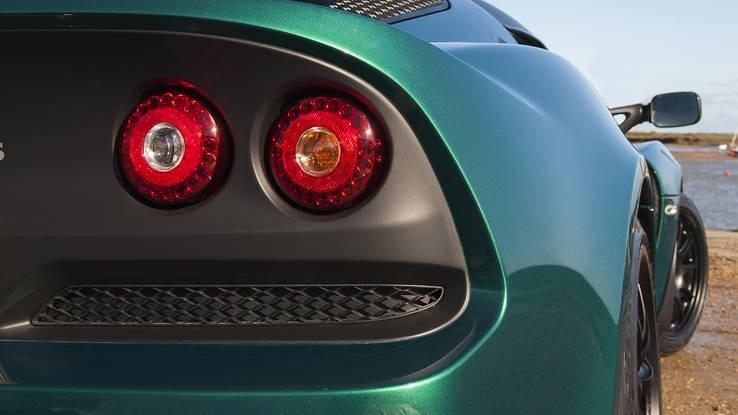
The four round tail lights carries over from the other Exige models, and we’re not mad about it.
Do I want it?
This is the niche Lotus could make its own: purer, more focused and cheaper than either the Porsche 911 GT3 or Cayman GT4, yet far more practical than many dedicated track cars, the Exige 350 Sport is an interactive driving experience that really shines on the racetrack. For now, that’s the only place you’d be able to use it, but our first drive on UK roads proves its perfectly capable of being daily driven too. For Lotus’ sake, let’s hope the next generation coming to the U.S. in 2019 or ’20 builds on the 350 Sport’s promise.




